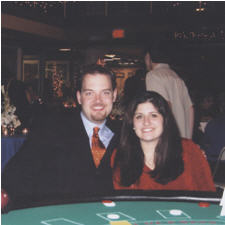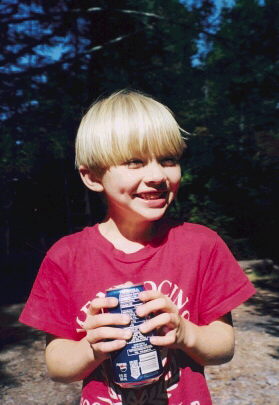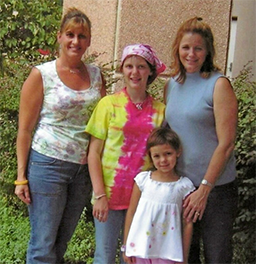
Christmas vacation had just ended and it was the beginning of a new year, 1993. I was fourteen-years-old, a freshman in high school, and had not been feeling well for some time. However, my physical complaints were quite vague which made it difficult for my pediatrician to identify the problem. Supposedly many things can cause headaches and as for the “aliens talking to me,” no one quite understood what I meant.
In January, the end of the junior varsity basketball season was approaching, and our team was going to be in the championships. Unfortunately my symptoms would not disappear.
I was determined to fight against them and tried hard to ignore my left temporal lobe migraines and the strange “sensations” occurring in my mind. These “sensations” caused me to lose concentration and made me unable to speak coherently or comprehend what other people were telling me. When I had a blackout on the basketball court, my parents took me to a doctor, and that was when I was soon to have an unexpected turn in my life.
My neurologist, a good friend of our family, immediately sent me for an EEG due to my recurrent awkward “feelings” and the blackout. Although the first EEG was relatively inconclusive, he recommended that I have an MRI just to be certain that nothing was wrong. The MRI was one of the scariest moments in my life. I was stuck in a large confined machine with banging all around which was not a typical situation for a young teenager. From that moment I could not let my parents out of my sight.
Once the MRI was complete, I did not give it much thought. I assumed that nothing was wrong until my doctor came to our house to give us the terrible news. The moment I knew he was coming to our house to personally give results, I knew that there was something wrong with me. At first, I refused to go into the living room with my neurologist and my parents since I was very nervous, emotional, and scared. Shortly thereafter, I was told that the scans revealed a left temporal lobe brain tumor which had to be removed. My awkward “feelings” were diagnosed as seizures. I was put on medication and my surgery was scheduled quickly. My only thought was Why did this happen to me? I was determined to get it over with so that I could go back to a normal high school life. By mid-March I was sent to the Johns Hopkins Hospital and was privileged to have one of the most well known pediatric brain surgeons perform my surgery, Dr. Benjamin Carson. I was eager to learn about Dr. Carson since I was putting my life into his hands; therefore, I read his autobiography called Gifted Hands. In addition, I felt special after watching Dr. Carson on the news and the Oprah Winfrey show. After listening and reading about Dr. Carson’s life and achievements, I felt more comfortable as I checked into the Johns Hopkins Children’s Center. The first night I was in the hospital, two terrifying things happened. The first was that I had to sign a set of death papers, and the second was when I was placed on an IV at midnight. My surgery was scheduled for 8 a.m. the next day, March 16 1993, the day after my mom’s birthday. I remember wearing my new pajamas, and my parents telling me “we’ll see you soon, lovie…” I do not remember much after that, but I later learned that the anesthesia kicked in within minutes. Ten hours later, I awakened in the ICU unit. I had my personal nurse Rob feeding me ice because my mouth was so dry. Supposedly my family and grandparents came into the ICU to visit me, but I was too fatigued to even remember. My left eye was completely swollen and purple, and I was wearing a big white bandage across my head.
I was in the ICU overnight. Unfortunately the day after my surgery, I was so weak due to a lack of blood that I immediately needed a blood transfusion. For the first couple days my mom had to bathe me, feed me, and help by walking me down the hallway with my IV. In addition to my anticonvulsant, Tegretol, I was taking steroids regularly to avoid any swelling. The amount of dosage and types of medications I was taking daily was unreal.
I do not remember much until a few days later when I was more awake and rested and receiving a continuous flow of visitors. The only comforting thing about being in the hospital was knowing how much my family, friends, and teachers cared about me. I was one of the luckiest children in the Johns Hopkins Hospital with the number of visitors, flowers, balloons, cards, and other gifts I received. The nurses also mentioned to me how I was such a considerate patient since I gave the children, who were without visitors, some of my balloons and flowers.

I was recovering nicely and had so much energy and optimism after my brain surgery that my doctors let me check-out six full days after my surgery. However, the horrible factor was that my head needed to “breathe.” All week I refused to have my bandage removed because I was too scared to see what I looked like. I was satisfied with it especially after my family decorated it with different colors and stickers. As Dr. Carson removed my bandages I noticed the neutral faces and silence coming from my family. At this point I was not sure what to expect. My first reaction to its removal was “Give me a mirror!” The left side of my head was shaved and the scar was huge! It was a scar shaped as the letter “C” and it was full of forty big staples. I remember crying for several hours until my parents finally calmed me down. I started trying on new hats and headbands and received many compliments which made me feel much better.
After resting a couple of weeks, I began home-schooling and continued with an amazing recovery. However, I still suffered seizures, but it was on a weekly to monthly basis rather than day to day. It was also emotionally difficult for me to cope with the fact that I would not be driving by the age of sixteen due to my seizures. After six weeks I went back to school. It was not easy for me because I received constant questions and stares especially since I disobeyed the school policy by wearing a hat everyday. My own identity became the Hat Girl. I felt as if people were scared of me since they knew I had “awkward moments”, otherwise known as seizures, which students were certainly not familiar with.
Over time, things for me cooled down. I had the staples removed, my hair began to grow, and I switched from hats to fabric headbands. I was still given constant attention from my family, teachers, church members, and other friends to see how I was doing. I eventually learned that my tumor was rare, but it was diagnosed as “dead” therefore had stopped growing. My thick brown hair took two years to grow back to its normal length, and I am convinced that as it grew it became thicker than it was before it was shaved.
It has been over seven years since the tumor diagnosis and surgery and I feel extremely fortunate. I continue to have annual MRIs and appointments with my neurologist and soon I hope to be off medication. I have been seizure-free for four years and was legally able to get my license last year. I graduated from Bucknell University in January 2000 with a Bachelor of Arts degree in Psychology and hope to pursue a career in the health care field. It is not easy putting my entire experience behind me; however, I have grown up knowing it is an experience in my life that has contributed a great deal to who I am today. Surprisingly, I am now able to openly discuss what had happened to me, and I have learned a lot about life. One of the things I will always know about this experience is that I was one of the lucky survivors!
This article was written by Marina Caminis, brain tumor survivor and graduate of Bucknell University.
This article was written for the Childhood Brain Tumor Foundation, Germantown, MD. Reviewed 2005

 Dash: The Big Dog of Superheroes
Dash: The Big Dog of Superheroes